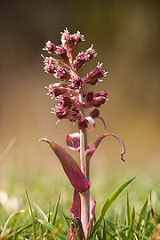
Common Butterbur
Encyclopedia
Common Butterbur is a herbaceous perennial plant in the family Asteraceae
, native to Europe
and northern Asia
. The flower
s are produced in the early spring, before the leaves
appear; they are pale pink, with several inflorescence
s clustered on a 5-20 cm stem. The leaves are large, on stout 80-120 cm tall stems, round, with a diameter of 40-70 cm.
It is also called Bog rhubarb, Devil's hat and Pestilence wort. Synonyms include P. officinalis, P. ovatus and P. vulgaris.
Nicholas Culpeper
called it "a great preserver of the heart and reviver of the spirits". Its many uses in folk medicine include applications as a diuretic
and muscle relaxant, and to treat coughs, fever, wounds, stammering, headaches, asthma and stress. Not all of these uses are supported by scientific research.
attacks. A commercial extract Petasol butenoate complex (Ze 339) has proved helpful for allergic rhinitis
An evidence-based 2005 systematic review including written and statistical analysis of scientific literature, expert opinion, folkloric precedent, history, pharmacology, kinetics/dynamics, interactions, adverse effects, toxicology, and dosing is available from the Natural Standard Research Collaboration.
Asteraceae
The Asteraceae or Compositae , is an exceedingly large and widespread family of vascular plants. The group has more than 22,750 currently accepted species, spread across 1620 genera and 12 subfamilies...
, native to Europe
Europe
Europe is, by convention, one of the world's seven continents. Comprising the westernmost peninsula of Eurasia, Europe is generally 'divided' from Asia to its east by the watershed divides of the Ural and Caucasus Mountains, the Ural River, the Caspian and Black Seas, and the waterways connecting...
and northern Asia
Asia
Asia is the world's largest and most populous continent, located primarily in the eastern and northern hemispheres. It covers 8.7% of the Earth's total surface area and with approximately 3.879 billion people, it hosts 60% of the world's current human population...
. The flower
Flower
A flower, sometimes known as a bloom or blossom, is the reproductive structure found in flowering plants . The biological function of a flower is to effect reproduction, usually by providing a mechanism for the union of sperm with eggs...
s are produced in the early spring, before the leaves
Leaf
A leaf is an organ of a vascular plant, as defined in botanical terms, and in particular in plant morphology. Foliage is a mass noun that refers to leaves as a feature of plants....
appear; they are pale pink, with several inflorescence
Inflorescence
An inflorescence is a group or cluster of flowers arranged on a stem that is composed of a main branch or a complicated arrangement of branches. Strictly, it is the part of the shoot of seed plants where flowers are formed and which is accordingly modified...
s clustered on a 5-20 cm stem. The leaves are large, on stout 80-120 cm tall stems, round, with a diameter of 40-70 cm.
It is also called Bog rhubarb, Devil's hat and Pestilence wort. Synonyms include P. officinalis, P. ovatus and P. vulgaris.
Herbalism
The herbalistHerbalist
An herbalist is:#A person whose life is dedicated to the economic or medicinal uses of plants.#One skilled in the harvesting and collection of medicinal plants ....
Nicholas Culpeper
Nicholas Culpeper
Nicholas Culpeper was an English botanist, herbalist, physician, and astrologer. His published books include The English Physician and the Complete Herbal , which contain a rich store of pharmaceutical and herbal knowledge, and Astrological Judgement of Diseases from the Decumbiture of the Sick ,...
called it "a great preserver of the heart and reviver of the spirits". Its many uses in folk medicine include applications as a diuretic
Diuretic
A diuretic provides a means of forced diuresis which elevates the rate of urination. There are several categories of diuretics. All diuretics increase the excretion of water from bodies, although each class does so in a distinct way.- Medical uses :...
and muscle relaxant, and to treat coughs, fever, wounds, stammering, headaches, asthma and stress. Not all of these uses are supported by scientific research.
Medicinal Uses
Some trials have shown a preparation of Butterbur root to be effective in reducing the frequency and severity of migraineMigraine
Migraine is a chronic neurological disorder characterized by moderate to severe headaches, and nausea...
attacks. A commercial extract Petasol butenoate complex (Ze 339) has proved helpful for allergic rhinitis
Allergic rhinitis
Allergic rhinitis, also known as pollenosis or hay fever, is an allergic inflammation of the nasal airways.It occurs when an allergen, such as pollen, dust or animal dander is inhaled by an individual with a sensitized immune system...
An evidence-based 2005 systematic review including written and statistical analysis of scientific literature, expert opinion, folkloric precedent, history, pharmacology, kinetics/dynamics, interactions, adverse effects, toxicology, and dosing is available from the Natural Standard Research Collaboration.
Further reading
- Howard, Michael. traditional folk Remedies (Century, 1987) P. 111.

